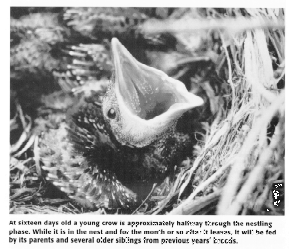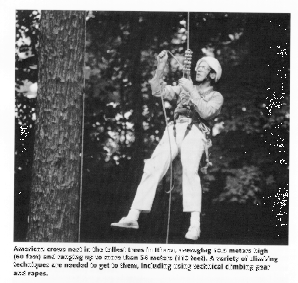
Reprinted with permission of Cornell Plantations, from Cornell Plantations Magazine, vol. 51 (1): 1-4, Spring/Summer 1996.
Family Lives of the Uncommon American Crow
KEVIN J. MCGOWAN

If you asked people who claim not to know anything about birds for a list of birds they know, chances are that the crow would be on virtually every list. Crows are common, large, noncryptic birds that are easily identified. Here in central New York, they are among the few birds that are obvious in the depths of winter other than chickadees at a feeder. But for all their familiarity, most people don't have a clue about the complex and interesting lives that crows lead.
I have been studying the two species of crows in Ithaca since I arrived at Cornell in 1988. The small fish crow (Corvus ossifragus) is an inconspicuous resident that has only a small population here. It is primarily a coastal inhabitant of the southeastern United States but has expanded its range dramatically in the last few decades, arriving in Ithaca in the mid-1960s. The second crow species, the American crow (Corvus brachyrhynchos), is the one that is familiar to most people in the area and the main subject of my studies. A huge population of American crows is present in the area, with at least 200 families breeding in town and thousands in the surrounding countryside. I once counted 1,200 crows going to roost one winter night in Cayuga Heights. Approximately 20 families live on the main campus of Cornell and the Plantations.
My research involves marking crows so that I can identify them later and know them as individuals. I mark primarily nestlings before they leave the nest and have climbed up to 120 feet to nests in some of the tallest trees in Ithaca. I then follow the progress of the young crows through subsequent years. By knowing the crows as individuals I can gather data on their survival, movement, associations, breeding success, and behavior.
Most young birds leave their parents soon after leaving the nest, often being chased away, and never see the parents again. In contrast, American crows never chase away their offspring, and the young may remain at home for years. Some crows stay with their parents for up to five years or even longer. (This past year one six-year-old crow that was marked the first year of my study was still associating with its younger siblings and, it appeared, with its unmarked parents.) Probably no crow breeds before it is two years old, and most don't breed until later than that. While they wait for a breeding opportunity, most crows help their parents raise young. They help feed the incubating female, feed the nestlings and fledglings, defend the territory and the nest, and stand guard over other family members while they forage. Such cooperative breeding behavior is rare in birds. Only a handful of species in North America exhibit it, and none are as widespread as the American crow.
 A successful family may raise from one
to six young from a nest; the average is three. Two of those
three will be alive and with the parents the next year, when they
may successfully raise another family. Those two will probably
still be with the parents the next year, along with two of their
younger siblings. Families quickly become large, with up to 15
crows moving around together. I have seen five adult crows at a
single nest at once, all with their heads in the nest feeding
young. Eventually some of the young die or disperse and the
family size drops. Of the roughly 200 nests I observed over the
first six years of the study, 80 percent were attended by three
or more crows. Average family size is 3.5.
A successful family may raise from one
to six young from a nest; the average is three. Two of those
three will be alive and with the parents the next year, when they
may successfully raise another family. Those two will probably
still be with the parents the next year, along with two of their
younger siblings. Families quickly become large, with up to 15
crows moving around together. I have seen five adult crows at a
single nest at once, all with their heads in the nest feeding
young. Eventually some of the young die or disperse and the
family size drops. Of the roughly 200 nests I observed over the
first six years of the study, 80 percent were attended by three
or more crows. Average family size is 3.5.
Young crows do not spend all their time at home but may wander for a while. During the winter the nonbreeding offspring may spend hours, days, or even weeks away from the home territory. Outside the breeding season, even breeders around Ithaca may join large flocks of crows foraging in corn stubble in the countryside and congregate in large roosts at night, but usually they are on the territory for at least part of every day throughout the year. Young crows may disappear for days, then come back and associate with the parents, disappear again, then return. Membership in the large and obvious foraging flocks in the fields changes constantly; few individuals are present in the same flock for more than a few days. Young crows may visit several large congregation areas throughout the winter, stopping at home in between. One tagged crow from my study was sighted spending the winter in Pennsylvania while one of its nest mates was at the family territory all winter. At the beginning of the breeding season, the southern wanderer was back with its parents in Cayuga Heights and helped them in their nesting attempt.
Family bonds may be retained for years even if the young do not remain at home. A two-year-old helper in one family I was observing disappeared. One day over a year later, it suddenly was back with its family, foraging amicably with the rest. The next day it was gone, and I have never seen it again. It appears that it just stopped in for a brief visit and was welcomed.
Often a young crow can find a breeding spot near its natal territory or even take part of the large parental territory for its own. Several families in my study have grown large, then split into smaller fragments, each with a single breeding pair. One curious aspect of this territorial budding is that sometimes the division is complete, with no more amicable interactions, and at other times family members wander back and forth between the neighboring territories. Observation of a relatively small sample of known-sex dispersers suggests that the differences can be explained by the sex of the budding offspring. If the leaving crow is a female, the separation is complete, but if it is a male, friendly relations may be retained. The explanation involves dominance and defense of territory. Dominance appears to be related primarily to sex; all males are dominant over all females. Older brothers have higher rank in a family than younger brothers, but those younger brothers can displace older sisters and perhaps even their mother. If a female crow pairs with the male next door, that male crow can keep all visiting crows away. He will not tolerate strange males in his territory and may chase strange females away as well. If a son pairs with the girl next door, she can do little to chase away visiting brothers-in-law. She could keep out her mate's sisters but cannot drive away the males. In some instances crows will move freely back and forth from parents' to brother's territory, but often a male will choose to stay with its brother almost exclusively. Perhaps on the death of the breeding male the brother will take over its breeding spot and pair with the female that it knows already.
Because crows delay breeding so long and can move so far away, I still do not have good estimates of how far they disperse from their natal territories to find breeding spots. A large number find breeding opportunities near their parents' territory, but of course these are the ones I am most likely to find. From the dispersals I have found, I know that a crow may make its first nest only 75 meters from the one in which it was hatched, or it might successfully find a breeding spot up to 65 kilometers ("as the crow flies"). I know that crows can disperse to at least 65 kilometers from Ithaca (a tagged crow was observed breeding in Geneva, New York). If I assume that crow densities are equivalent throughout a 65-kilometer circle around Ithaca, I calculate that crows from my study disperse into a population of at least 125,000 crows. Thus although I have marked more than 550 crows, I am never surprised when people tell me, "I see lots of crows, but I never see any of your tagged ones." The area is filled with devoted families of this large and interesting bird.
Kevin McGowan is a senior research associate in the Section of Ecology and Systematics and is the curatorial associate in charge of the ornithology and mammalogy collections.
Return to Kevin J. McGowan's publications page.
Return to Kevin J. McGowan's home page.
Return to Kevin's crow reference page.